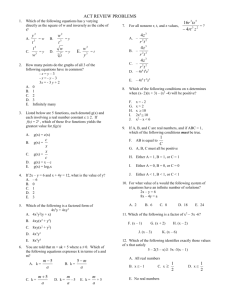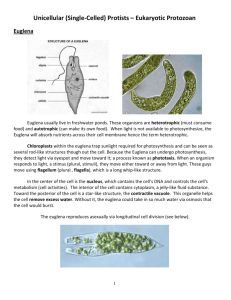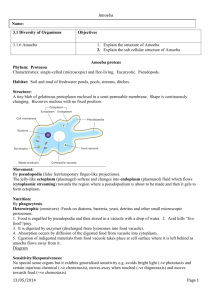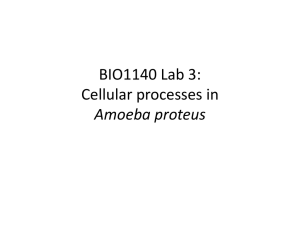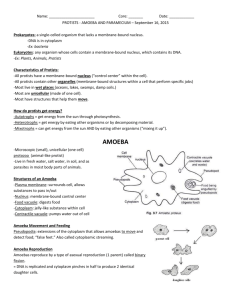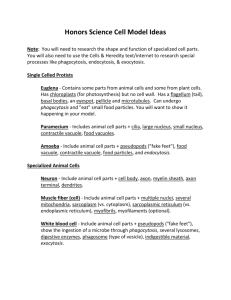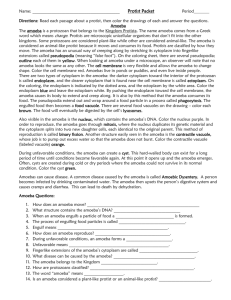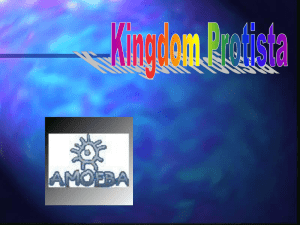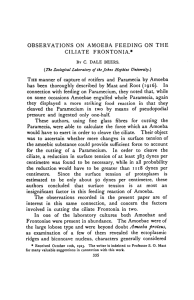Protozoa (amoeba)
advertisement
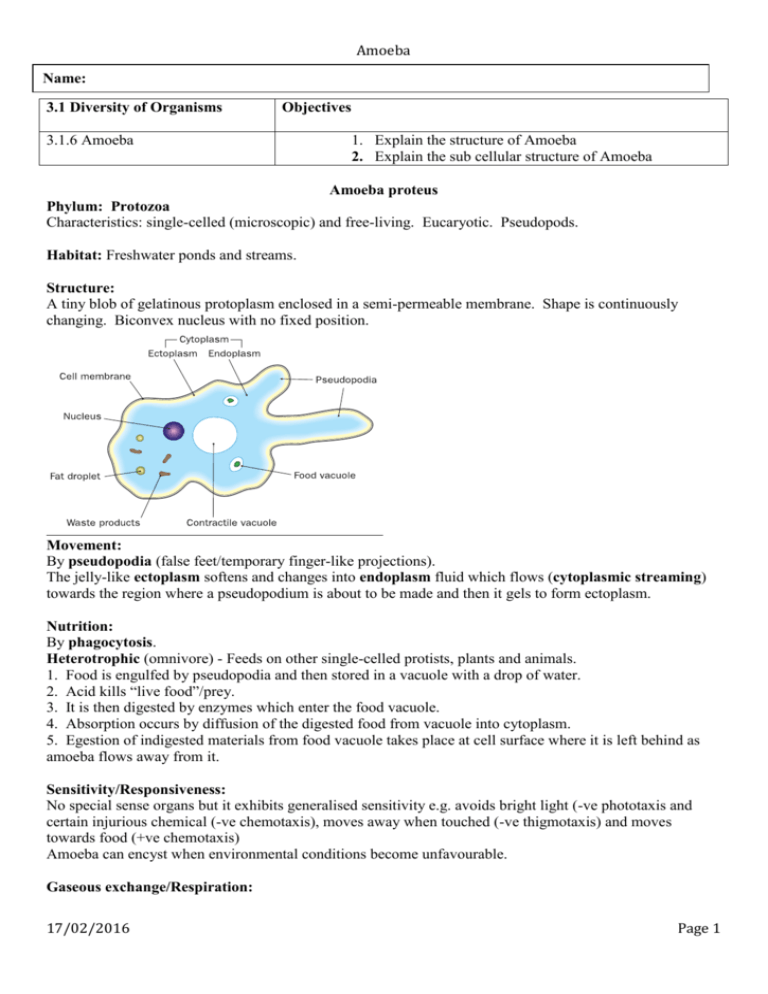
Amoeba Name: 3.1 Diversity of Organisms Objectives 3.1.6 Amoeba 1. Explain the structure of Amoeba 2. Explain the sub cellular structure of Amoeba Amoeba proteus Phylum: Protozoa Characteristics: single-celled (microscopic) and free-living. Eucaryotic. Pseudopods. Habitat: Freshwater ponds and streams. Structure: A tiny blob of gelatinous protoplasm enclosed in a semi-permeable membrane. Shape is continuously changing. Biconvex nucleus with no fixed position. Movement: By pseudopodia (false feet/temporary finger-like projections). The jelly-like ectoplasm softens and changes into endoplasm fluid which flows (cytoplasmic streaming) towards the region where a pseudopodium is about to be made and then it gels to form ectoplasm. Nutrition: By phagocytosis. Heterotrophic (omnivore) - Feeds on other single-celled protists, plants and animals. 1. Food is engulfed by pseudopodia and then stored in a vacuole with a drop of water. 2. Acid kills “live food”/prey. 3. It is then digested by enzymes which enter the food vacuole. 4. Absorption occurs by diffusion of the digested food from vacuole into cytoplasm. 5. Egestion of indigested materials from food vacuole takes place at cell surface where it is left behind as amoeba flows away from it. Sensitivity/Responsiveness: No special sense organs but it exhibits generalised sensitivity e.g. avoids bright light (-ve phototaxis and certain injurious chemical (-ve chemotaxis), moves away when touched (-ve thigmotaxis) and moves towards food (+ve chemotaxis) Amoeba can encyst when environmental conditions become unfavourable. Gaseous exchange/Respiration: 17/02/2016 Page 1 Amoeba Oxygen diffuses in from water and carbon dioxide out through the membrane. Efficient process because thin and large surface area to volume ratio. Excretion: Carbon dioxide and nitrogenous wastes are excreted through cell membrane by diffusion. Osmoregulation: 1. The contractile vacuole eliminates excess water which comes as a by-product of respiration or enters the cell by osmosis (amoeba is hypertonic). 2. Water is actively transported into the contractile vacuole. Hence many mitochondria surround the contractile vacuole producing the necessary ATP/energy. 3. The vacuole gradually increases in size and when full moves through cytoplasm to surface of cell where it bursts and expels the water. Marine amoeba are isotonic to water and therefore have no contractile vacuole. Reproduction (asexual): By binary fission. Given a good supply of food, 20oC an amoeba will grow and reproduce asexually by binary fission every two days. Nucleus splits in two by mitosis and then the cytoplasm splits into two halves. Clone - a group of genetically identical individuals e.g. Amoeba 17/02/2016 Page 2 Amoeba 2010 HL 3. The diagram shows the structure of Amoeba. (a) Name the parts labelled A, B and C. A ………………………………. B ……………………………….. C ……………………………...... (b) To which kingdom does Amoeba belong? ….………………………………………………………… (c) Is the cell of Amoeba prokaryotic or eukaryotic? ….…………………………………………………. (d) Give a reason for your answer to part (c) ....………………………………………………………….. (e) Give one function of A in Amoeba ……………………………………………………………............ (f) 1. Give one function of B in Amoeba …………………………………………………………....... 2. Suggest one reason why B is more active in freshwater amoebae than in marine amoebae. …………………………………………………………………………………………………………… 2005 OL 6. (a) The diagram shows the structure of Amoeba. (i) Name A, B, C, D. A ……………………………. B ………………………………. C ……………………………. D ………………………………. (ii) To which kingdom does Amoeba belong? ….………………………………….. 2012 OL 2. Amoeba is a tiny, one-celled organism. This diagram shows the structure of a freshwater Amoeba as seen through a microscope. 17/02/2016 Page 3 Amoeba (a) Name the parts labelled A, B, C and D. A. ____________________________ B. ______________________________ C. _____________________________ D. ______________________________ (b) State: one function of part A. ______________________________________________________________ one function of part C. ______________________________________________________________ (c) Give one difference between a plant cell and an amoeba. 2011 HL 14. (c) (viii) Name the structure by which Amoeba gets rid of excess water that has entered by osmosis. Marking scheme 2010 HL Q3 3. (a) A = pseudopods (false feet); B = contractile vacuole; C = food vacuoles (b) Protista or Protoctista 3 (c) Eukaryotic 3 (d) Membrane-bound organelles or named membrane-bound organelle [allow nucleus] 3 (e) Feeding (or explained) or movement 3 3 (f) 1. Osmoregulation or explained [allow excretion or homeostasis] 2. Freshwater more hypotonic or more H2O intake or reference to concentration difference 3, 2, 1, 0 2 2005 OL Q6 6. 10 answers (a) (i) (ii) 2(6)+8(1) A = contractile/ vacuole B = cytoplasm / endoplasm C = pseudopod / false foot D = nucleus / organelle Protista / Protoctista 2012 OL Q2 2. 2(1)+3(2)+2(6) (a) 17/02/2016 A = Contractile Vacuole B = Cytoplasm / Endoplasm C = Pseudopodium / False Foot D = Nucleus Page 4 Amoeba (b) Function “A” = Water balance / Osmoregulation Function “C” = Movement / Feeding / Egestion/ Homeostasis (c) e.g. Plant Cell has Cell Wall 2011 HL Q14(c) (c) (viii) Contractile vacuole 14 17/02/2016 3 Page 5
